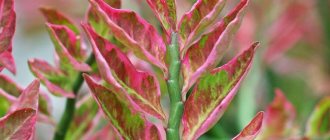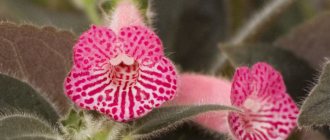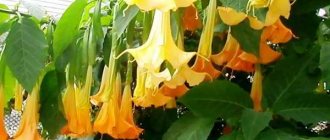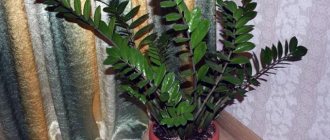Photo of a blooming Epiphyllum is a beautiful flowering succulent from the Cactus family. In indoor culture it is grown as an hanging plant. Characterized by long, branched stems with flat or triangular edges. The flowers are large, funnel-shaped. It is also called phyllocactus.
At the base they are covered with small scales and spines. In nature it develops as an epiphyte; in indoor conditions it grows well on a substrate. Epiphyllum is native to tropical and subtropical regions of South America.
Also be sure to see how to grow prickly pear indoors.
| Average growth rate. |
| Blooms in spring and summer. |
| The plant is easy to grow indoors. |
| Perennial. |
Beneficial features
Epiphyllum oxypetalum.
Photo The fleshy fruits of phyllocactus can be eaten. Their healing properties were already known to the indigenous Indians. In folk medicine, the juice and leaves of the Dreamland epiphyllum variety are used to treat psoriasis and as an intestinal cleanser.
Why doesn't the cactus bloom?
How to make epiphyllum bloom? If the conditions of keeping the cactus are not acceptable, then it may not bloom. This happens due to strong shade and abundance of watering in winter. The buds do not set and if the room temperature is too high during the winter months, it is fed with nitrogen fertilizers. In order for a cactus to gain color, its maintenance conditions must be appropriate.
If the flower receives little sunlight, then it is better to place it closer to the window or change the side of the room. Flowering improves significantly if nitrogen fertilizers are removed from the fertilizing composition. So, not the foliage will grow, but the cactus will devote all its energy to lush flowering. It is necessary not to disturb the dormant period and give it a rest so that the cactus gains strength and begins to bloom luxuriantly.
Features of growing at home. Briefly
Epiphyllum is grown quite simply at home:
| Temperature | Room temperature in summer, +13-15° in winter. |
| Air humidity | Needs periodic spraying. |
| Lighting | Bright, diffused, without direct sunlight. |
| Watering | Abundant in summer, 1-2 times a month in winter. |
| Priming | Light, fertile with mandatory drainage. |
| Feeding and fertilizer | During the period of intensive growth, once every 2 weeks. |
| Transfer | As it grows in the spring. |
| Reproduction | Cuttings and sowing seeds. |
| Features of cultivation | During the flowering period, the plant should not be rotated. |
Emerging problems
Diseases
Diseases affecting Epiphyllum are:
- Rust occurs from waterlogging of the soil during cooling, from the accumulation of moisture on the stem, or from burns by the rays of the sun. It looks like untidy spots of a rusty hue. Treatment with a fungicide and regulation of care conditions is necessary.
- Black rot affects the stems - spots with a black sheen. Control - removal of affected areas and chemical treatment.
- Anthracnose is a light brown spot. It is necessary to cut out diseased stems and spray with fungicide.
- Fusarium rotting of roots from chronic waterlogging and redness of stems. You should remove diseased roots, replant the plant and monitor watering.
Pests
Among the pests that are especially dangerous for Phyllocactus are:
- Spider mites - they suck nutritious juices from the plant and appear in fairly dry conditions. Control measures include increasing humidity and treating with acaricide.
- Aphids - by sucking cell sap, disrupt the development process of the cactus, and in addition, they are a carrier of viruses. Insecticide treatment required.
- Mealybugs slow down the growth of the cactus by sucking out nutritious juices and leaving a waxy coating. The plant is infected with viral diseases. To eliminate the pest, you need to wipe the cactus with alcohol or a detergent solution. If necessary, apply chemical treatment.
- Scale insects harm the development of the plant. Control measures include inspecting the stems and removing bugs. As a last resort - chemical treatment.
Epiphyllum: care at home. Details
Caring for epiphyllum at home should be carried out in compliance with certain rules.
Bloom
The flowering period of leaf cactus occurs at the end of spring - beginning of summer. Mature, well-developed plants are abundantly covered with large, fragrant flowers of white, red or pink. Each flower lasts about 5 days.
How to stimulate flowering
To stimulate the flowering of epiphyllum, all old shoots are cut out on the plant in the fall. If it was kept at high temperatures in winter, another pruning is carried out in the spring.
During pruning, all thin and elongated shoots are removed.
Temperature
Epiphyllum is grown at a temperature of +23-25°. With the beginning of autumn, the temperature must be reduced to +15°. It winters well even at +5°, so if you have an insulated loggia or veranda, you can take it there.
Spraying
Homemade epiphyllum adapts perfectly to the ambient air humidity. But if the temperature in the room rises above +26°, the plant must be sprayed daily. Spraying is also necessary during the period of intensive growth of leaf mass and during flowering.
Lighting
Bright but diffuse lighting is necessary. Windows facing east or west are best suited for growing it. You can grow a succulent from the north side, but in this case the flowering will be weak.
In order for the bush to develop evenly, the pot with the plant must be turned periodically. However, this should not be done once buds begin to form and during flowering. All the flowers may simply fall off.
Watering
In summer, water regularly and abundantly. But at the same time, the soil surface should dry out a little between waterings. In winter, the plant is watered very rarely. Usually 1-2 times a month is enough. When the temperature drops to +5°, watering is stopped completely.
Pot
The epiphyllum plant is grown indoors in spacious plastic or ceramic containers. The main thing is that drainage holes are made in their bottom. Despite the fact that it loves moisture, stagnation of moisture is destructive for it.
Priming
To grow epiphyllum, light, fertile soil is used. To compose the soil mixture, humus, turf soil and sand are used, they are taken in equal proportions. An industrial substrate for cacti is also suitable for growing. Before use, it is mixed with peat in a 1:1 ratio.
Feeding and fertilizer
During the period of intensive growth and during flowering, feed every 2 weeks.
For fertilizing, choose fertilizers with a high content of phosphorus and potassium; nitrogen is harmful to it.
Transfer
Epiphyllum is transplanted after the end of the flowering period. The plant is first allowed to rest for a month and only then replanting begins. Young, intensively growing specimens are replanted annually. Older plants as they grow, every 2-3 years.
Trimming
Epiphyllum needs constant pruning. It is carried out in the fall, before the start of the dormant period. All woody, crooked and damaged shoots are removed from the plant. Moderation should be observed when pruning. Buds are formed only on last year's shoots.
Rest period
For abundant flowering, epiphyllum requires a period of rest. Plants kept warm also bloom, but not as long and profusely. The dormant period lasts from late October to February.
During this period they are kept at +10-12°.
Rest period
The cessation of growth and flowering in most epiphyllums occurs in winter. It is during this period that there is no need to wash the flower and fertilize it. They also reduce spraying and watering, and monitor the temperature - too hot a temperature is not very favorable for the cactus.
One interesting fact that not all epiphyllum owners know about is the gift of fruit. After flowering, a kind of peduncle is attached to the stem - this is the fruit that can be eaten! Since it is prickly, it is first cleared of thorns. Most people who have tasted the epiphyllum fruit associate the mixture of persimmon and banana flavors.
Growing epiphyllum from seeds
Like the vast majority of other succulents, it is easy to grow from seed. They are sown in the soil mixture without subsequent incorporation. To maintain high humidity, planting containers are covered with film and kept at a temperature of +25°. Crops must be ventilated periodically, removing accumulated condensate.
Shoots appear in 2-3 weeks. After this, the film is immediately removed. First, the seedlings acquire a faceted shape, which is not typical for epiphyllum; they will become flat after 3-4 months of cultivation. Plants grown from seeds bloom after 4-5 years.
How to choose?
You should approach the purchase of epiphyllum very responsibly. The type of specimen you choose determines not only its lifespan, but also how efficiently the plant can bloom and bear fruit.
When purchasing a phyllocactus, pay attention to its appearance.
Stems and leaves should be a uniform, rich green color without spots, cobwebs or dried areas, as these signs may indicate the presence of pests or diseases, including viral ones. There should also be no damage to the stems - choose a plant with dense shoots whose integrity is not compromised.
Buy a cactus without flowers and buds, since when transporting the epiphyllum they may fall off and these areoles will not bloom again.
Proper pruning of epiphyllum is an important aspect of caring for the plant at home. It is necessary to cut off at the base weak, damaged shoots that are very elongated due to improper care. In mature plants, old, cork-covered shoots that do not form buds should be removed. When starting to trim flat stems, you should remember: the color of the cactus is formed on those stems that have grown during the previous year. Those stems that have already bloomed once will not be able to produce more color. But it is permissible to cut them off only after 3 years, since their presence is important in the life support process of the phyllocactus. You also need to cut off the buds that have bloomed. All cut areas must be treated with crushed coal.
How to properly trim an epiphyllum is demonstrated in the video - watch it and get additional information on questions that interest you:
Propagation of epiphyllum by cuttings
The tops of well-developed last year's shoots are suitable for propagation. Cuttings 10-15 cm long are cut from them. Their base must be given a wedge-shaped shape. After this, the cuttings are dried for 2-3 days until a characteristic glassy crust forms on the cut. For planting, use clean sand or soil for succulents.
Cuttings are planted vertically to a depth of 1 cm. Plants grown from cuttings bloom the next year.
Cuttings can also be rooted above water. To do this, after drying, they are fixed in a container so that their lower part is as close as possible to the surface of the water. After the formation of root primordia, the cuttings are immediately planted in the substrate.
Transplantation process
This procedure is performed only if necessary, it is better when the epiphyllum has completely faded. Transplantation is done when the pot becomes too small for the overgrown roots. The new container should be wide and low, because the plant’s root system is weak. After transplanting, it is recommended to put the flower in the shade and water it very little.
Diseases and pests
Flower growers very often face a number of problems:
- Epiphyllum does not bloom. The flowering period may be absent due to non-compliance with wintering conditions, lack of lighting, or excess nitrogen in the soil. It is necessary to adjust the conditions of maintenance, providing the plant with proper wintering with a sufficient level of illumination.
- The buds have fallen. The problem occurs when turning or moving the plant.
- Black spots on the leaves appear as a result of the development of black rot. The affected plant must be treated with a fungicide, for example, Fundazol.
- Light brown spots on the leaves indicate the development of a fungal infection. Fungicides are also used for treatment.
- Yellow-red spots on the leaves are the result of water entering the sun when watering.
- The roots rot. The problem occurs when there is excessive watering and lack of drainage. To save the plant, an emergency transplant is carried out with the removal of rotten roots.
- Shoots wrinkle and lose turgor with a lack of moisture and exposure to the sun. The plant must be provided with sufficient watering by moving the pot to a place with diffused lighting.
- Epiphyllum leaves are cracking . When using fertilizing with nitrogen, leaf blades may crack. Fertilizer application must be temporarily stopped.
The most common pests are mealybugs, spider mites, and thrips. To combat them, special insecticides are used.
Diseases
Epiphyllum without good care will become an object for diseases. The plant is susceptible to fungal infection and viral mosaic.
Viral mosaic infection is very difficult to cure
When a flower is watered with cold water, over time it becomes covered with round spots - these are signs of a fungal infection. Darkening is clearly visible on the stems. You need to dig up the bush, dry the roots, removing damaged ones, and treat the entire crown and roots with a fungicidal preparation. In the future, try not to flood the flower.
If small white spots appear on the stems, it means that the plant has become infected with viral mosaic. It is extremely difficult to save a diseased epiphyllum; it is better to prevent the disease by protecting it from contact with diseased flowers.
Types of home epiphyllum with photos and names
The following types are most often used in indoor floriculture:
Epiphyllum anguliger or angular Epiphyllum anguliger
A highly branched species with rounded or triangular stems that become woody at the base. The length of the stems can reach 1 meter or more. The flowers are medium-sized and bright red.
Epiphyllum oxypetalum
The species is characterized by large plants up to 3 meters high. The stems are flat with wavy edges. The flowers are very large, their average diameter is 15 cm or more.
Epiphyllum hookeri
Characterized by long, cascading stems and white flowers. It grows naturally in Cuba.
Epiphyllum crenatum
The stems are bluish-green in color, up to 80 cm long, with carved edges. The diameter of the flowers is about 15 cm. Their color varies depending on the variety.
Epiphyllum phyllanthus Epiphyllum phyllanthus
It grows naturally in South America. The length of the shoots reaches 1 meter. The flowers are pink, very large.
Guatemalan epiphyllum Epiphyllum guatemalense
The stems consist of parts shaped like oak leaves. The size of each individual link is about 5 cm. The flowers can be pink, red or white.
Epiphyllum ackermanii
The stems are flat, drooping with jagged shoots at the base. The flowers are bright red and sit on a characteristic thin stalk.
Epiphyllum Laui Epiphyllum laui
A species with large stems covered with very thin needles up to 4 mm long. The flowers are milky or creamy and open only in the evening. They stay on the plant for about 2 days.
Botanical description
Epiphyllum, or phyllocactus, or forest cactus, is a succulent plant with long, branching stems, drooping or creeping, sometimes with wavy edges. The stems can be flat or triangular, they are equipped with aerial roots. It is these stems that are mistakenly called epiphyllum leaves. The large, white, funnel-shaped phyllocactus flowers can reach a length of 40 cm and open both day and night. They are so beautiful that the plant is called epiphyllum orchid. Epiphyllum fruits are large, often prickly, reddish in color, edible, with a banana-pineapple-strawberry flavor.
Most often, epiphyllum is grown as an ampelous plant.
Interesting facts about the plant
This cactus is actively used for medical purposes to treat pathologies of the heart and blood vessels, stomach and intestines. It is also used to treat neurological diseases. It protects the human body from the effects of electromagnetic radiation.
The juice of the plant is used for migraines, colds, and rheumatism. It is a natural diuretic, thickens the blood during bleeding, and relieves hangover. They can also treat psoriasis and reduce inflammation. It accelerates tissue repair and helps cleanse the blood. Treatment with tinctures from the plant is effective for stress and apathy.











